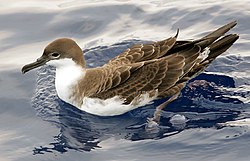Greater shearwater
| Great shearwater | |
|---|---|
 |
|
| Scientific classification | |
| Kingdom: | Animalia |
| Phylum: | Chordata |
| Class: | Aves |
| Order: | Procellariiformes |
| Family: | Procellariidae |
| Genus: | Ardenna |
| Species: | A. gravis |
| Binomial name | |
|
Ardenna gravis (O'Reilly, 1818) |
|
| Synonyms | |
|
Procellaria gravis O'Reilly, 1818 |
|
Procellaria gravis O'Reilly, 1818
The great shearwater (Ardenna gravis; formerly Puffinus gravis) is a large shearwater in the seabird family Procellariidae. Ardenna was first used to refer to a seabird by Italian naturalist Ulisse Aldrovandi in 1603, and gravis is Latin for "heavy".
The great shearwater's relationships are unclear. It belongs in the group of large species that have been separated as genus Ardenna (Penhallurick & Wink 2004); within these, it might be allied with the other black-billed, blunt-tailed species, the short-tailed shearwater and especially the sooty shearwater (Austin 1996, Heidrich et al. 1998). Alternatively (Austin 1996, Austin et al. 2004), it could be a monotypic subgenus (Ardenna sensu stricto), an Atlantic representative of the light-billed Hemipuffinus group (pink-footed shearwater and flesh-footed shearwater).
This species breeds on Nightingale Island, Inaccessible Island, Tristan da Cunha, and Gough Island. It is one of only a few bird species to migrate from breeding grounds in the Southern Hemisphere to the Northern Hemisphere, the normal pattern being the other way round. This shearwater nests in large colonies, laying one white egg in a small burrow or in the open grass. These nests are visited only at night to avoid predation by large gulls.
This shearwater, like the sooty shearwater, follows a circular route, moving up the eastern seaboard of first South and then North America, before crossing the Atlantic in August. It can be quite common off the south-western coasts of Great Britain and Ireland before heading back south again, this time down the eastern littoral of the Atlantic.
...
Wikipedia

